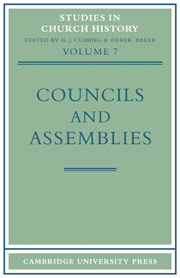Book contents
- Frontmatter
- Preface
- Contents
- Contributors
- Abbreviations
- Public welfare and social legislation in the early medieval councils (Presidential Address)
- National synods, kingship as office, and royal anointing: an early medieval syndrome
- The case of Berengar of Tours
- Ecclesiastica and Regalia: Papal investiture policy from the Council of Guastalla to the First Lateran Council, 1106–23
- Viri religiosi and the York election dispute
- Councils and synods in thirteenth-century Castile and Aragon
- The Byzantine reaction to the Second Council of Lyons, 1274
- The Council of London of 1342
- Education in English ecclesiastical legislation of the later Middle Ages
- The representation of the universitas fidelium in the councils of the conciliar period
- Nicholas Ryssheton and the Council of Pisa, 1409
- The condemnation of John Wyclif at the Council of Constance
- Some aspects of English representation at the Council of Basle
- The Council of Basle and the Second Vatican Council
- The Colloquies between Catholics and Protestants, 1539–41
- King James I's call for an ecumenical council
- John Hales and the Synod of Dort
- Assembly and Association in Dissent, 1689–1831
- The Convocation of 1710: an Anglican attempt at counter-revolution
- Laymen in synod: an aspect of the beginnings of synodical government in South Africa
- The First Vatican Council
- Kikuyu and Edinburgh: the interaction of attitudes to two conferences
Viri religiosi and the York election dispute
Published online by Cambridge University Press: 12 March 2010
- Frontmatter
- Preface
- Contents
- Contributors
- Abbreviations
- Public welfare and social legislation in the early medieval councils (Presidential Address)
- National synods, kingship as office, and royal anointing: an early medieval syndrome
- The case of Berengar of Tours
- Ecclesiastica and Regalia: Papal investiture policy from the Council of Guastalla to the First Lateran Council, 1106–23
- Viri religiosi and the York election dispute
- Councils and synods in thirteenth-century Castile and Aragon
- The Byzantine reaction to the Second Council of Lyons, 1274
- The Council of London of 1342
- Education in English ecclesiastical legislation of the later Middle Ages
- The representation of the universitas fidelium in the councils of the conciliar period
- Nicholas Ryssheton and the Council of Pisa, 1409
- The condemnation of John Wyclif at the Council of Constance
- Some aspects of English representation at the Council of Basle
- The Council of Basle and the Second Vatican Council
- The Colloquies between Catholics and Protestants, 1539–41
- King James I's call for an ecumenical council
- John Hales and the Synod of Dort
- Assembly and Association in Dissent, 1689–1831
- The Convocation of 1710: an Anglican attempt at counter-revolution
- Laymen in synod: an aspect of the beginnings of synodical government in South Africa
- The First Vatican Council
- Kikuyu and Edinburgh: the interaction of attitudes to two conferences
Summary
Any discussion of the conciliar assemblies and decisions of the Church is likely to consider things from the centre—to enumerate those present, to distinguish the issues, arguments, and protagonists, and to emphasize the final decisions. Perhaps, indeed, to over-emphasize them, for there is a tendency to assume that what was decreed at Rome was rapidly implemented in the provinces. Often, of course, this was the case, and the speed with which the decisions of the Third Lateran Council were disseminated is striking testimony to the ability of the twelfth-century Papacy to publicize its policies. The Papacy developed rapidly, however, in the middle years of the twelfth century, and it is dangerous to assume that what was true of the pontificate of Alexander III can also be applied to that of Innocent II. It may therefore be useful to look closely at a major provincial dispute from the first half of the twelfth century, and to attempt to determine how decisively regional practice was affected by papal decrees in one particular instance.
The death of Archbishop Thurstan of York on 6 February 1140 marks an epoch in the history of the northern province. Homo magnarum rerum et totius religionis amator, as the historian of Fountains styles him, Thurstan was the last and greatest in the line of able Norman prelates who had rebuilt the Church, under all its aspects, in the North of England.
- Type
- Chapter
- Information
- Councils and Assemblies , pp. 87 - 100Publisher: Cambridge University PressPrint publication year: 1970



